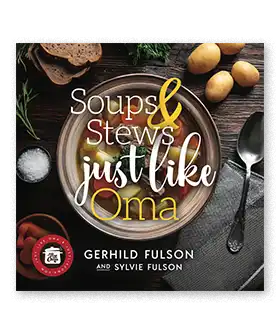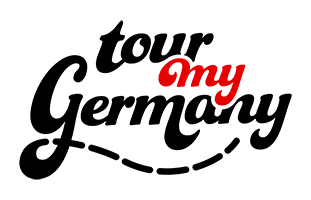Spice up your inbox with FREE German recipes and an exclusive free recipe ebook!
Warm up this winter with Oma's newest cookbooks - available on Amazon >>
Spice up your inbox with FREE German recipes and an exclusive free recipe ebook!
- Home
- German Food Culture
- What is Endive
What Is Endive? How To Prepare and enjoy it

by: Gerhild Fulson / Oma Gerhild shares German recipes rooted in family tradition.
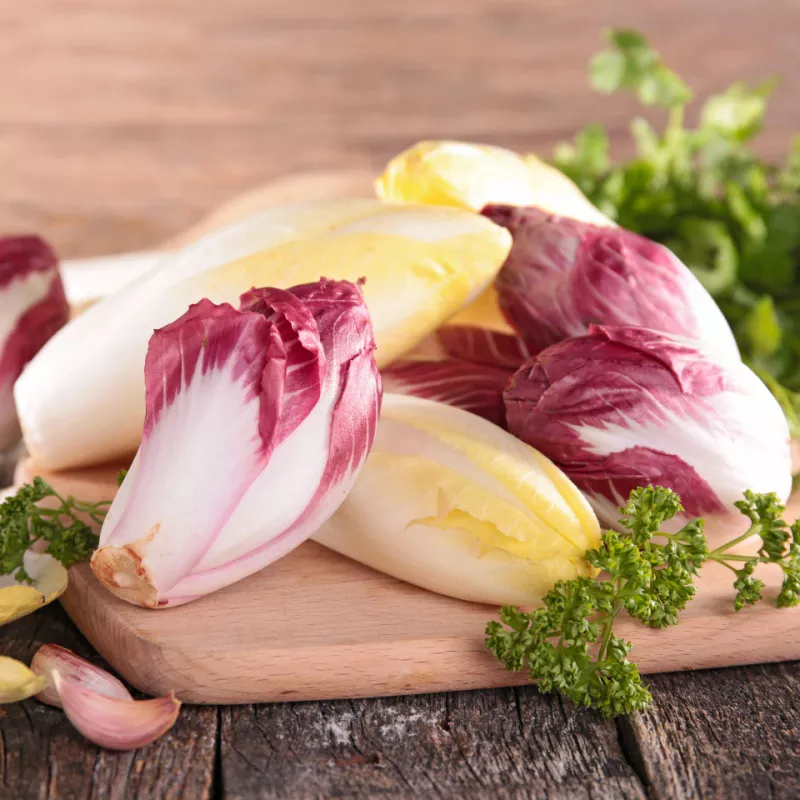 Fresh Belgian Endive and Radicchio ready to be used in so many dishes.
Fresh Belgian Endive and Radicchio ready to be used in so many dishes.Growing up, my Mutti never used endive (endivie). It wasn’t something I ever saw in our kitchen in Canada (nor, according to her, something she made in Germany). That all changed when I took my first trip back to Germany in 2006.
One day, my Ferienwohnung (a vacation rental, similar to an Airbnb) host surprised me with a basket of fresh produce, including a peculiar vegetable I had never seen before.
Curious, I asked, Was ist Endivie? (What’s Endive?)
She explained that it was a common ingredient in German kitchens, a slightly bitter leafy green often used in salads or cooked dishes. I had no idea what to do with it, but I was determined to figure it out.
After doing some research, I came to find out that endive is a type of chicory, and what to do with it and its counterparts.
Endive And Chicory: what’s what?
Types Of Endive (Cichorium Endivia)
- Curly Endive (Frisée) – Bushy, finely curled green leaves with a sharp, bitter taste; commonly used in salads with warm dressings.
- Escarole (Broad-Leafed Endive) – Large, broad, slightly curled leaves with a milder bitterness; often used in soups, sautés, or Italian dishes.
Types Of Chicory (Cichorium Intybus)
- Belgian Endive (Witloof, Chicorée) – Small, tightly packed, pale yellow leaves with a nutty, mild bitterness; can be eaten raw, grilled, or braised.
- Radicchio – Vibrant red-purple leaves with white veins and a bitter, slightly spicy flavor; used in salads, grilled, or roasted.
- Sugarloaf Chicory – Looks similar to romaine lettuce but has a mildly bitter, crisp texture; great in salads or cooked like cabbage.
- Puntarelle – Long, hollow green shoots with a bitter crunch; a staple in Italian cuisine, often served with anchovy dressing.
- Catalogna Chicory (Italian Dandelion) – Long, thin, deep green leaves with a strong bitterness; often blanched or sautéed.
- Root Chicory – The roasted roots are used to make chicory coffee, commonly found in France and New Orleans-style blends.
Favorite Varieties Of Chicory
> Frisée (Curly Endive)
Frisée, also called curly endive, has bushy, finely curled green leaves and a sharp, peppery bite.
In Germany, it's commonly tossed with crispy bacon and a warm mustard dressing, a combination that intrigued me but also made me wonder how best to balance its bitterness.
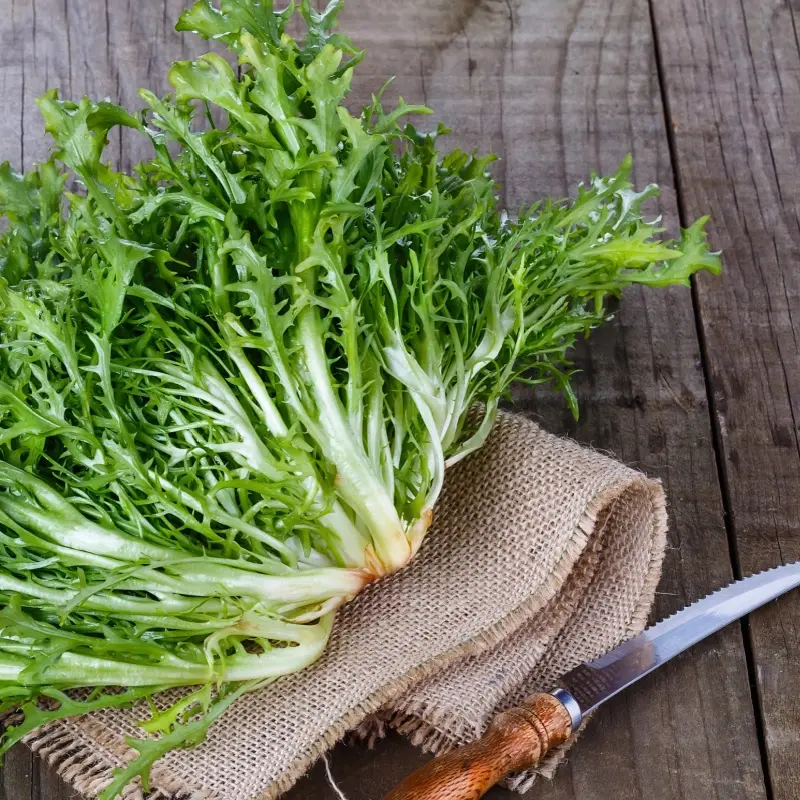 Curly Endive also known as Frisée ready to be used
Curly Endive also known as Frisée ready to be used> Belgian Endive
Belgian endive, on the other hand, is a small, tightly packed, pale yellow head with slightly curled edges. What fascinated me most was how, unlike most greens, it has a two-stage growing process. It's why Belgian endive tends to be pricier than other greens.:
- First, the roots grow in the field like any leafy green.
- Then, the roots are harvested and placed in a dark, humid space, where they sprout again.
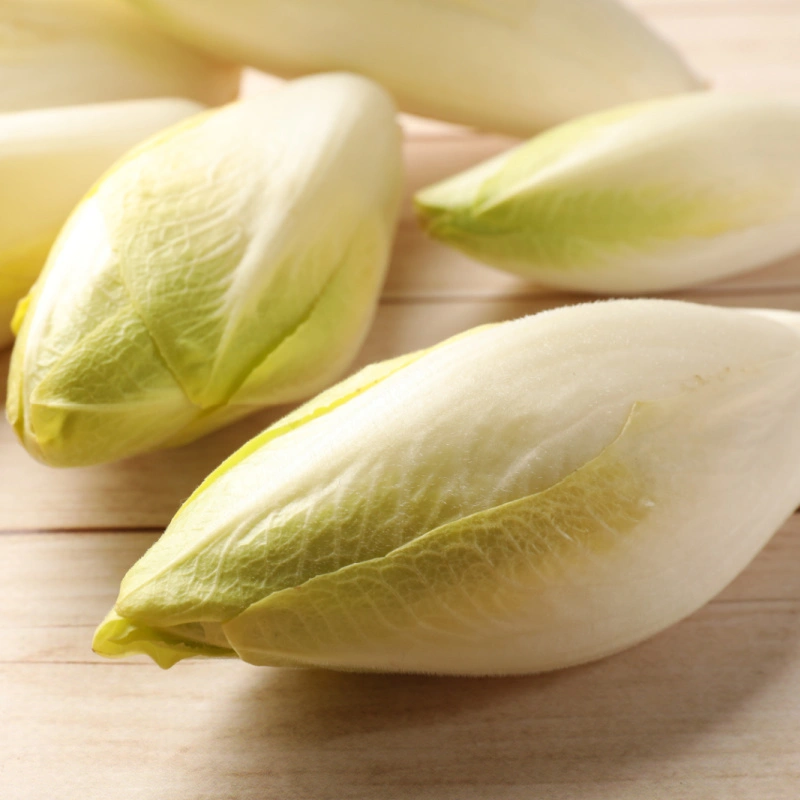 Belgian Endives ready to be used
Belgian Endives ready to be usedBecause the leaves never see sunlight, they remain pale, crisp, and milder in bitterness than their curly endive cousins. This unusual and labor-intensive process gives Belgian endive a crisp, slightly nutty flavor, and it’s often braised, roasted, or eaten raw in salads.
Oma says,
Now, I’d love to say that I fell in love with endive right away, but the truth is—I wasn’t quite sure what to make of it. I first tried it in a salad, and the bitterness caught me off guard. Clearly, I had a lot to learn about how to balance its strong flavor.
I was blessed to have my online German friend, Nicole, share her Endivien Untereinander recipe with me. In English, that would be known as German Endive Hodgepodge or Endive Mash.
I made a version of her endive recipe with mashed potatoes mixed with endive, caramelized onions, and crispy bacon. The result? A surprisingly comforting dish! The potatoes helped mellow the bitterness, and the bacon added just the right amount of smoky richness.
It wasn’t something I had ever eaten growing up, and while I wouldn’t say it became a staple in my kitchen, mainly because it’s difficult to find the endive in our stores. I must say, I appreciate the unusual way Germans used endive in so many dishes.
How To Use Endive and Chicory
Serve It Raw
- Belgian endive salads – Chopped and tossed with a sweet dressing (like honey mustard) to balance the bitterness.
- Endive boats – Used as little cups for herbed quark, smoked salmon, or blue cheese.
- Frisée with bacon dressing – A classic German way to serve it, though I still find it quite strong.
Serve It Cooked
- Braised Belgian endive – sautéed in butter with a splash of German beer.
- Endive in mashed potatoes – The way I've made it the most.
- Sautéed escarole – a milder cousin of endive, it works well with garlic and olive oil.
- Bacon-wrapped Belgian endive – looks like a perfect dish for a party
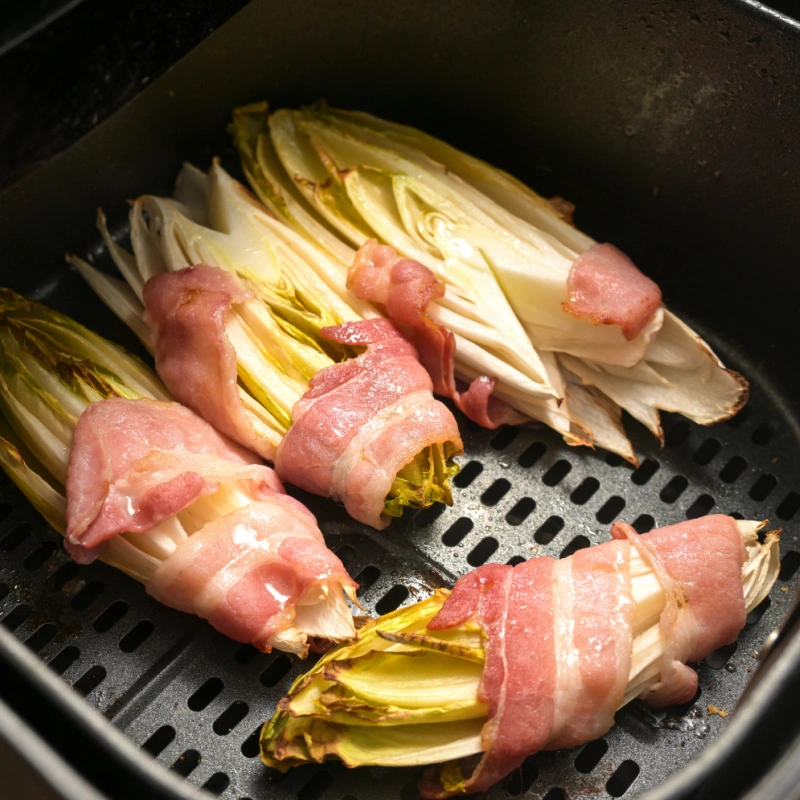 Endive wrapped in bacon and air fried
Endive wrapped in bacon and air friedHow To Prepare Endive
> How To Prepare Curly Endive (Frisée)
Curly endive, or frisée, is looser and more delicate than Belgian endive, so it needs a bit more attention when washing.
- First, remove any wilted or yellowed outer leaves and then cut off the tough root end.
- Since its tightly curled leaves tend to trap dirt, soak it in a bowl of cold water, swishing it around to loosen any grit.
- Lift the leaves out, drain, and repeat if needed.
- After washing, dry it thoroughly using a salad spinner or by patting with a clean kitchen towel—this is especially important if you're making a salad, as dressing won’t stick well to damp leaves.
- Once dry, tear or chop into bite-sized pieces, and it’s ready to be tossed with a warm bacon dressing, creamy cheese, or nuts to balance its bitterness.
> How To Prepare Belgian Endive
Belgian endive has tight, compact leaves that need minimal preparation.
- To get it ready for cooking or salads, start by removing any wilted or damaged outer leaves.
- Then, trim off the root end, but be careful not to cut too much—you want to keep the leaves attached.
If you’re using it raw in a salad or as an appetizer, slice it crosswise into thin ribbons or separate the whole leaves to use as edible scoops for dips, cheeses, or smoked salmon.
If cooking, slice it in half lengthwise and gently rinse under cold water, as dirt can sometimes be trapped near the core.
To reduce bitterness, some people like to cut out the small, firm core at the base, especially when braising or roasting.
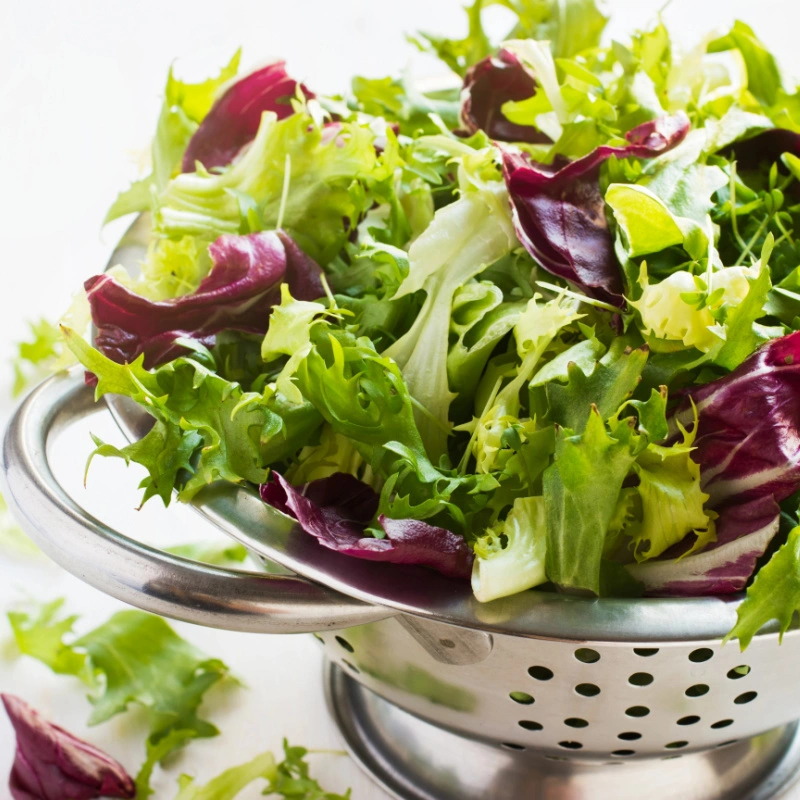 A mix of chicory, endive, and lettuces ready for salad making
A mix of chicory, endive, and lettuces ready for salad makingHow To Choose & Store Endive
> Choosing the Best Endive
Belgian endive should have tight, crisp leaves with a pale yellow or white color (green leaves mean more bitterness).
Curly endive (frisée) should have fresh, vibrant green leaves, without wilting or brown spots.
> Keeping Endive Fresh
Store Belgian endive wrapped in a paper towel inside a perforated bag in the fridge—it will keep fresh for a week.
Curly endive and escarole should be stored loosely in the crisper drawer, since they need airflow.
Traditional German Recipes With Endive to Try
Whether it’s chopped into a salad, sautéed with bacon, or tucked into mashed potatoes, endive has a distinct flavor that adds a bit of complexity to a meal.
If you’ve never tried it, I encourage you to experiment with frisée or Belgian endive—even if it takes a few tries to find a way you like it!
- Endivien Untereinander (Mashed Potatoes with Endive & Bacon)
- Warm Chicory with Honey Mustard Dressing (Chicorée Salat)
- Bacon-Wrapped Endive (Endiviensalat im Speckmantel)
- Braised Belgian Endive (Geschmorter Chicorée)
- Frisée Salad with Poached Egg & Bacon (Frisée mit Speck & Ei)
Comments? Questions?
You can leave a comment about this recipe or ask a question...
Pop right over to my private Facebook group, the Kaffeeklatschers. You'll find thousands of German foodies, all eager to help and to talk about all things German, especially these yummy foods.
Meet with us around Oma's virtual table, pull up a chair, grab a coffee and a piece of Apfelstrudel, and enjoy the visit.
Recent Articles
-
Oma's German Donuts Recipe (Berliner / Krapfen)
Dec 10, 25 02:05 PM
Looking for real German donuts? These Berliner, aka Krapfen, are Oma-style classics, soft, lightly sweet, and perfect for filling, sharing, and reminiscing. -
German Gingerbread House Recipe: Oma's Traditional Lebkuchen
Nov 13, 25 07:27 AM
German Gingerbread House Recipe: A simple, spiced lebkuchen, honey cake perfect for building and decorating your own festive holiday centerpiece. Fun and delicious for all! -
German Pork Noodle Soup – Oma's Nudelsuppe mit Schweinefleisch Rezept.
Nov 05, 25 09:50 PM
Homemade pork noodle soup ... so easy to make a huge potful to satisfy the hungriest of families or a large party.
Top of What is Endive
















